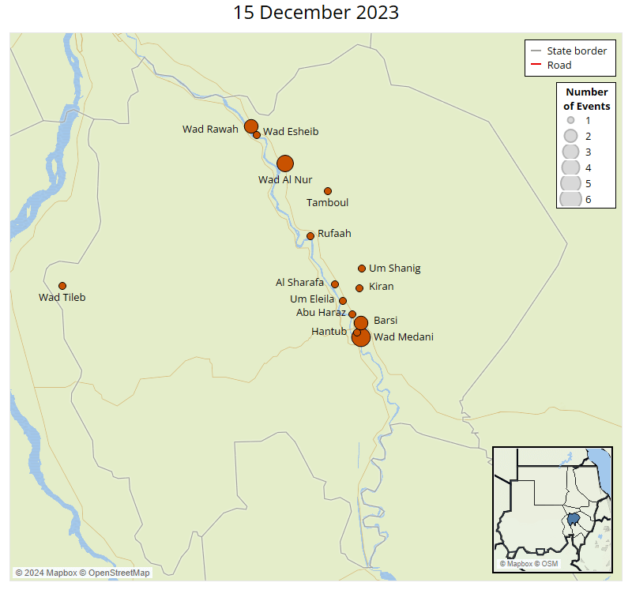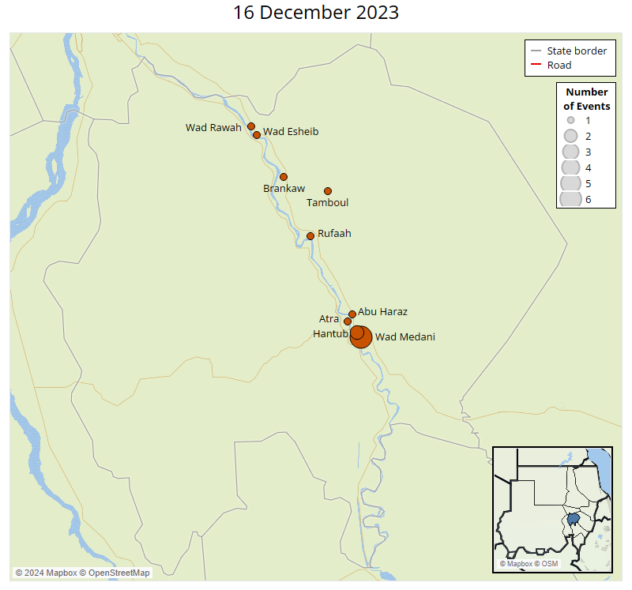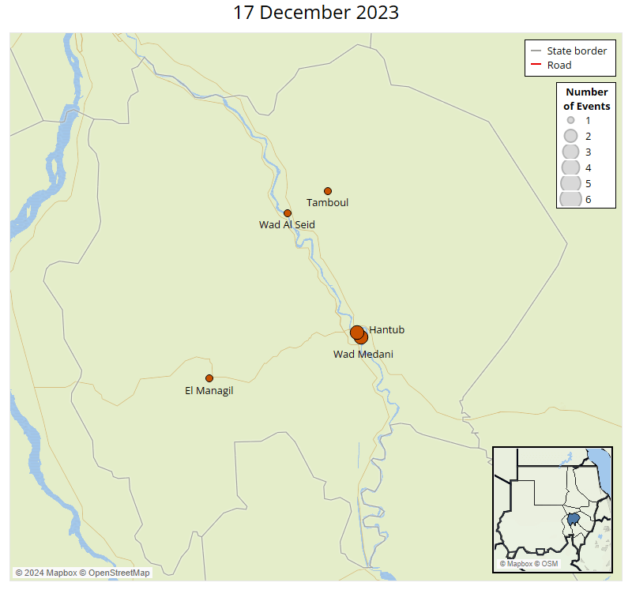Situation Update | January 2024
Sudan: The Rapid Support Forces (RSF) Gains Ground in Sudan
12 January 2024
VITAL TRENDS
- Since fighting first broke out between the Sudanese Armed Forces (SAF) and paramilitary Rapid Support Forces (RSF) on 15 April, ACLED records nearly 4,000 events of political violence and more than 13,000 reported fatalities in Sudan.
- From 25 November 2023 to 5 January 2024, ACLED records over 640 political violence events and 720 reported fatalities.
- Most political violence events were recorded in Khartoum state during the reporting period, with over 440 events and 315 reported fatalities. The second highest political violence events were recorded in al-Jazirah state, with over 70 events and over 110 reported fatalities.
- The most common event type was explosions/remote violence, with 323 recorded, followed by battles and violence against civilians, with over 235 and 80 events, respectively. Compared to the previous six weeks, ACLED records a 7% decrease in battles and a 56% increase in explosions and remote violence in Sudan.

The Rapid Support Forces (RSF) Gains Ground in Sudan
More than eight months into the war between the SAF and the RSF, the RSF has launched new offenses into previously peaceful areas. During the latter part of 2023, the SAF experienced successive defeats, often withdrawing from its bases and leaving cities defenseless in the face of RSF advances. The RSF inflicted significant blows to the SAF, and seized control of nearly all of Darfur states and al-Jazirah state (see map below). Meanwhile, the two armies continued to fight in Khartoum’s tri-city area to secure supply routes. After the RSF took control of al-Jazirah state’s capital, Wad Madani, on 18 December, two strategic changes were observed in many SAF-controlled states.
The RSF has thus turned the tide, gaining the upper hand in the conflict. Yet, new developments began to emerge. Several states launched mobilization campaigns, arming self-defense militias as a result of the string of defeats suffered by the SAF. Additionally, ethnic and communal militias also began to mobilize against the RSF in SAF controlled areas. All the while, the RSF leadership is seeking legitimacy, domestically and abroad, preparing for a new phase of the war in 2024.
Security and Mobilization After the Fall of al-Jazirah
After the conflict between the RSF and the SAF broke out in April 2023, Wad Madani emerged as a critical humanitarian hub, hosting hundreds of thousands of internally displaced people (IDP) escaping the conflict in Khartoum. It served as the initial destination for those leaving the capital before seeking refuge in other countries or Sudanese states, owing to its strategic location in the southeast of Khartoum.1Alperen Aktaş, ‘Sudanese governorate of Al-Qadarif declares state of emergency amid RSF conflict,’ Anadolu Agency, 17 December 2023 In the early stages of the conflict, limited clashes were confined to the northern areas of al-Jazirah state, close to the border with Khartoum. In October 2023, the RSF began to extend its control of Sharg al-Nile locality by taking over al-Aylafon in Khartoum near the border of al-Jazirah. This area contained the last SAF base in the southeastern part of Khartoum.
On 15 December 2023, the RSF initiated a large-scale offensive against the SAF, with RSF forces advancing toward the outskirts of Wad Madani, where the clashes concentrated for three days in at least 17 distinct towns and villages (see map below). In response, the SAF closed the Hantoub bridges linking Sharg al-Jazirah to Wad Madani to impede the RSF from drawing near the city.
Political Violence in al-Jazirah: 15-18 December 2023




On 18 December, SAF troops began withdrawing from Wad Madani, Hantoub, al-Hasahisa, and al-Kamlin cities into Sennar state. They removed shipping containers that had been placed as obstacles on the Hantoub bridge, unblocking access for the RSF.2Mohammed Amin, ‘Sudan: Soldiers accuse army of betrayal after retreat leaves Wad Madani to RSF,’ Middle East Eye, 20 December 2023 Consequently, the RSF gained control of Wad Madani and most other cities in al-Jazirah state. Facing mounting criticism for failing to protect the city from the advancing RSF troops, the SAF announced an investigation into the events leading to the withdrawal, citing suspicions of potential collaboration between SAF commanders and the RSF.
During the attack in al-Jazirah, there were widespread atrocities committed by the RSF. RSF troops were accused of looting several civilian populated areas, while also killing and raping local residents and displaced citizens.3Hudhaifa Ebrahim, ‘EXCLUSIVE: Murders, Rapes, Hangings Rampant in War-Torn Sudan, Smuggled Birth Control Pills Draw Premium,’ The Media Line, 2 January 2024; Strategic Initiative for Women in the Horn Africa, ‘Statement: CSOs Condemn the Escalating Violence in Sudan as the War reaches Wad Madani and Al Gezira State,’ 24 December 2023. In December alone, amid RSF advances in several states, at least 200,000 people are reported to have fled al-Jazirah, Sennar, and White Nile states, a significant portion of whom were already displaced from Khartoum and other regions in Sudan.4United Nations Office for the Coordination of Humanitarian Affairs, ‘Sudan Humanitarian Update,’ 4 January 2024 After gaining control of Wad Madani and al-Haj Abdallah, the RSF restricted civilian movement by preventing them from fleeing to Sennar.5Mat Nashed, ‘No way to leave’: Sudan paramilitary traps civilians in breadbasket state,’ Al Jazeera, 29 December 2023 This action further exacerbated the challenges of accessing humanitarian aid and the last few functioning health facilities by civilians attempting to escape the conflict zones, contributing to the overall humanitarian crisis in the region.
The fall of al-Jazirah triggered panic across the remaining SAF-controlled states and communities in these territories. The unjustified and surprising collapse of the SAF — especially when the destruction of the Hantoub Bridge could have been an option to prevent Wad Madani from falling into the hands of the RSF — raises concerns over the ability of the SAF to resist RSF advances. Wad Madani was a strategic location where the army could reinforce its defenses on the northern front in al-Jazirah state, adjacent to Khartoum, via the western side of the Blue Nile river. Unsurprisingly, fresh clashes also erupted for the first time in Sennar state on 23 December, with the RSF reportedly reaching positions 15 kilometers away from the state capital. This panic manifested in heightened security measures announced across River Nile, Northern, White Nile, Blue Nile, Kassala, Gedaref, and Red Sea states.6European Commission, ‘ECHO Daily Flash of 19 December 2023,’ 19 December 2023 Furthermore, ethnic and communal militias began significant mobilization against the RSF, reflecting a loss of confidence in the SAF’s ability to defend them and raising suspicions of collaboration between the SAF commanders and RSF.7Mat Nashed, ‘Sudan’s civilians pick up arms, as RSF gains and army stumbles,’ Al Jazeera, 24 December 2023.
Battles Continue in Khartoum
In the Khartoum tri-city area, airstrikes and artillery shelling hit the capital almost daily during the reporting period, marking a significant escalation of remote violence. From 25 November 2023 to 5 January 2024, ACLED records a 57% increase in remote violence in the capital compared to the previous six weeks. Since overtaking Jabal Awlia and other strategic supply routes around the capital, the RSF repaired the bridge over the Jabal Awlia dam, destroyed during the fighting on 18 November.8Reuters, ‘Sudanese warring parties trade blame for damaged dam south of Khartoum,’ 18 November 2023; Sudan War Monitor, ‘Updates on military developments in Sudan as another round of peace talks fails,’ 5 December 2023 However, SAF warplanes bombed the bridge again on 2 December, making it unserviceable. The Jabal Awlia bridge serves as a critical link between Khartoum and Omdurman, offering the RSF an alternative route to reach Khartoum after the Shambat bridge was also bombed on 11 November 2023.
Armed clashes have since concentrated in and around SAF military bases and RSF positions across the capital. The SAF conducted airstrikes and artillery shelling on RSF positions, and the RSF responded by targeting SAF bases with artillery shelling and clashing with the SAF multiple times. The RSF advanced south from Jabal Awlia to White Nile state to impede the grouping of the SAF troops and secure the bridges in Ad Douiem, establishing it as a core route connecting the west and east sides of the White Nile river.9X @rybar_force, 25 December 2023 Consequently, clashes expanded to Tendelti and Ad Douiem, as well as al-Gitina, which the RSF took control of on 21 December.
The Aftermath of RSF Domination in Darfur
Following the RSF’s capture of four out of the five states in Darfur in November, concerns about an RSF assault on El Fasher city, the capital of the remaining SAF-held North Darfur state, prompted mobilization among Darfur rebel groups and ethnic militias to defend the city. As tensions heightened, all parties involved in the Darfur conflict deployed troops, including the SAF, the RSF, the factions of Minnawi, Abdul Wahid al-Nur, and Tambor of Sudan Liberation Movement/Army (SLM/A), Justice and Equality Movement Jibril Ibrahim faction, and various ethnic militias, including the Zaghawa. The SLM/A-Minnawi faction and Justice and Equality Movement Jibril Ibrahim faction were united under the banner of the Darfur Joint Forces.10Sudan Tribune, ‘Darfur Joint Force deploys more troops to protect civilians,’ 2 December 2023; Sudan War Monitor, ‘RSF threaten Babanusa; SLA reinforce El Fasher; SAF bomb Khartoum market,’ 25 November 2023 To avoid confrontations in the city, the RSF withdrew 620 combat vehicles from El Fasher and its surrounding areas to Kordofan on 28 November, claiming it was a coordinated move agreed upon with Darfur Joint Forces, a claim the Darfur Joint Forces later denied.11Sudan War Monitor, ‘RSF deputy leader: ‘We decided to control all of Darfur, and El Fasher is no exception.’,’ 28 November 2023 Meanwhile, the SAF fortified positions around the 6th Infantry Division headquarters.
On 29 November, the SAF conducted airstrikes targeting the withdrawing RSF convoy from El Fasher to Kordofan in Umm Kadadah. These airstrikes did not deter the RSF, which moved to capture the city of Umm Kadadah, located 180 kilometers east of El Fasher, without facing resistance from the SAF troops. Subsequently, clashes between the SAF and the RSF also erupted in El Fasher on 16 December, lasting for two days and occurring in the Melit Gate area, Abuja, Nevasha IDP Camp, and Abu Shouk IDP Camp, resulting in at least eight people killed.
Violence against civilians persisted in many areas of Darfur even after the RSF’s takeover, largely due to RSF raids and SAF airstrikes. In Central Darfur, the non-aggression pact between the SLM/A-Abdul Wahid al-Nur faction (SLM/A-AW) and the RSF collapsed after the RSF attacked civilians.12Radio Dabanga, ‘Sudan conflict: RSF clash with SLM-AW faction in western Jebel Marra,’ 26 December 2023 The two groups clashed on 23 and 24 December, resulting in dozens of casualties. As a result, both sides agreed to form a committee to address the issue. The SLM/A-AW asserted that the conflicting parties were ‘outlaws’ and not representative of their group.13Sudan War Monitor, ‘Darfur rebels deny clashes with RSF in Nertiti,’ 26 December 2023
In South Darfur, the RSF withdrew from Deribat in Sharg Jabal Marrah locality, allowing the SLM/A-AW to nonviolently regain control.14Sudan Tribune, ‘SLM-Abdel Wahid forces seize RSF camp in South Darfur,’ 3 December 2023 The SLM/A-AW has expanded its control to several locations around Jabbal Marrah in North, South, and Central Darfur states since September. The group’s gains have capitalized on the ongoing conflict between the SAF and the RSF. The RSF has avoided engaging with actors other than the SAF, and thus, by maintaining a neutral stance, the SLM/A-AW is able to act without fear of confrontation from the RSF. On the other hand, the SAF is actively seeking allies to bolster its support in the conflict and would not target a potential ally.
Embracing the Unknown: What is Next?
The capture of al-Jazirah by the RSF stands as a defining moment in the ongoing conflict with the SAF. This event has not only led to an expansion of hostilities into new territories, particularly in the middle regions such as Sennar state, but it has also brought forth threats of RSF attacks on River Nile, Gedaref and Port Sudan. Simultaneously, the fall of Wad Madani city has triggered ethnic mobilization across areas under SAF control, casting doubt on the SAF’s ability to protect these regions. Furthermore, this situation has the potential to prompt defections within the SAF ranks in response to their withdrawal from Wad Madani, with many Sudanese calling the SAF chief Abdel Fattah al-Burhan to step down.15Mat Nashed, ‘‘Remove him’: Sudan army chief al-Burhan faces calls to go after RSF gains,’ Al Jazeera, 20 December 2023
The situation remains highly volatile, with the unexpected fall of al-Jazirah adding a new layer of complexity to a conflict initially concentrated in Khartoum, Darfur, and Kordofan. In the meantime, the RSF shows no signs of halting its expansion, potentially preparing to launch new offensives on Sennar and White Nile. To capture El Fasher in North Darfur, the RSF appears to rely on their suspected allies, such as the head of the Gathering of Sudan Liberation Forces, al-Tahir Hajar, and the head of the SLM-Transitional Council, al-Hadi Idris. The two notables arrived in El Fasher on 8 January, with some reports suggesting that the goal of their visit was to negotiate with the SAF 6th Infantry Division about handing over the city to the RSF.16X @PatrickHeinisc1, 9 January 2024 The claim was later denied by these two groups.17Sudan Tribune, ‘Al-Hadi Idris reiterates neutrality and unity of Darfur joint forces,’ 8 January 2024. This development could dissolve the Darfur Joint Forces, triggering defections within each group and internecine fighting between the constituent members of the alliance.
Shortly after the capitulation of Wad Madani, the RSF leader, Mohamed Hamdan Dagalo, ‘Hemedti,’ traveled to Uganda, Ethiopia, Djibouti, Kenya, South Africa, and Rwanda for bilateral discussions with regional governments. This move appears more as a public relations maneuver than a sincere effort to bring an end to the conflict. Despite a momentary glimmer of hope with the Addis Ababa Declaration signed on 2 January 2024 between Hemedti and Abdalla Hamdok, former prime minister and current representative for the Coordination of Civilian Democratic Forces, known as Taqaddum,18Sudan Tribune, ‘Full Text: Addis Ababa Declaration,’ 2 January 2024 prospects for peace were dashed when SAF General Abdel Fattah al-Burhan declared a categorical rejection of reconciliation with the RSF on 5 January.19Xinhua, ‘Sudan’s army chief rules out reconciliation with paramilitary forces,’ 5 January 2024 This declaration triggered widespread controversy, with the Resistance Committees and the Sudanese Communist Party contending that Taqaddum went beyond its initial mission, which was to cease the war and provide humanitarian aid, by engaging into political discussions.20Radio Dabanga, ‘Sudan’s Tagaddum seeks to build ‘broadest democratic civil front possible’,’ 10 January 2024; Sudan Tribune, ‘Sudanese communists denounces Addis Ababa Declaration for failing to address urgent priorities,’ 6 January 2024





